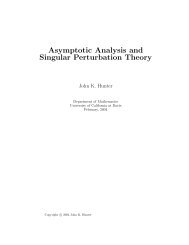The Riemann Integral
The Riemann Integral
The Riemann Integral
You also want an ePaper? Increase the reach of your titles
YUMPU automatically turns print PDFs into web optimized ePapers that Google loves.
14 1. <strong>The</strong> <strong>Riemann</strong> <strong>Integral</strong><br />
1.2<br />
1<br />
0.8<br />
y<br />
0.6<br />
0.4<br />
0.2<br />
0<br />
0 0.2 0.4 0.6 0.8 1<br />
x<br />
Figure 2. <strong>The</strong> graph of the monotonic function in Example 1.22 with a countably<br />
infinite, dense set of jump discontinuities.<br />
<strong>The</strong> proof for a monotonic decreasing function f is similar, with<br />
sup<br />
I k<br />
f = f(x k−1 ),<br />
inf<br />
I k<br />
f = f(x k ),<br />
or we can apply the result for increasing functions to −f and use <strong>The</strong>orem 1.23<br />
below.<br />
□<br />
Monotonic functions needn’t be continuous, and they may be discontinuous at<br />
a countably infinite number of points.<br />
Example 1.22. Let {q k : k ∈ N} be an enumeration of the rational numbers in<br />
[0,1) and let (a k ) be a sequence of strictly positive real numbers such that<br />
∞∑<br />
a k = 1.<br />
Define f : [0,1] → R by<br />
f(x) = ∑<br />
k∈Q(x)<br />
a k ,<br />
k=1<br />
Q(x) = {k ∈ N : q k ∈ [0,x)}.<br />
for x > 0, and f(0) = 0. That is, f(x) is obtained by summing the terms in the<br />
series whose indices k correspond to the rational numbers 0 ≤ q k < x.<br />
For x = 1, this sum includes all the terms in the series, so f(1) = 1. For<br />
every 0 < x < 1, there are infinitely many terms in the sum, since the rationals<br />
are dense in [0,x), and f is increasing, since the number of terms increases with x.<br />
By <strong>The</strong>orem 1.21, f is <strong>Riemann</strong> integrable on [0,1]. Although f is integrable, it<br />
has a countably infinite number of jump discontinuities at every rational number<br />
in [0,1), which are dense in [0,1], <strong>The</strong> function is continuous elsewhere (the proof<br />
is left as an exercise).
















